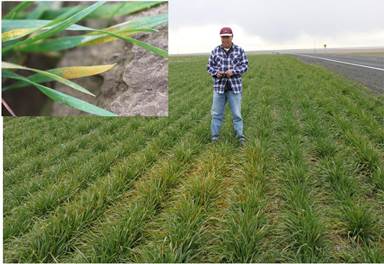Xianming Chen
With the weather conditions, warm and moist, so far this fall, we expect to see stripe rust in early planted winter wheat fields. Yesterday, we were checking fields in the Walla Walla and Horse Heaven Hills areas. Most fields in the Walla Walla area were planted relatively late, which is helpful in reducing stripe rust infection in the fall, and we couldn’t find rust in few fields with relatively big plants. Stripe rust were found in several fields with big plants in the Horse Heaven Hills area. Severity was mostly 1-5% and incidence less than 1%. One big “hotspot” was about four feet in diameter (see the picture below) with severities more than 60%. Stripe rust was also found in a field along Highway 26 between Othello and Washtucna. The unusual high and widespread of stripe rust in this time of the year has been due to the following factors: 1) the later than normal maturing wheat crops and the prolonged rust epidemic season in eastern Washington provided heavy inoculum, 2) the mild late summer weather allowed much more spores to survive, 3) good moistures in the fall allowed seeds to emerge quickly, and 4) the warm and moist weather condition allow plants to have grown fast and increased the initial infection and also have allowed secondary infections. More importantly, most of the hard red winter wheat cultivars do not have effective all-stage resistance against infection in the seedlings.
Whether the rust in the field now will cause a big epidemic in next spring or not will depend upon the weather conditions this winter. If the winter is much colder than normal, much of the rust will die. However, if the winter is warmer than normal, stripe rust will develop very early after winter and likely to a big epidemic. We will have our first forecast for next year after January.
Stem rust was also found in a couple of the fields. We will check next spring to see if the pathogen is able to overwinter there.
Several fields were heavily infested by bird cherry-oat aphids. Root rot symptoms were common in some of the fields with big plants.
Stripe rust was also collected in the recent weeks by colleagues in Montana, southern Idaho, and Minnesota.

Fig. 1. Actively sporulating leaves and a big “hotspot” of stripe rust found in a winter wheat field on November 9, 2009 in the Horse Heaven Hills. (Photo by Dr. Anmin Wan)